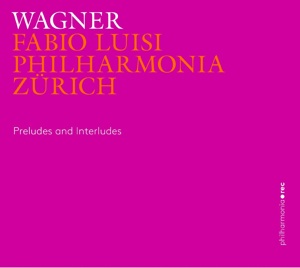
“Disciplined and intelligent.” “Clean and transparent.” “Fleet and lithe.” Though Fabio Luisi’s Wagner performances draw frequent praise for their tidy professionalism, there’s often an undercurrent of frustration with the Genoese maestro for not wringing a little more blood out of the scores, or putting a personal stamp on them. Frequent work in the house where James Levine reigns has a way of creating invidious distinctions, even when clear vision and tasteful restraint can be welcome virtues.
Luisi is now trying to make Wagner a calling card for the Philharmonia Zurich, the pit band of that city’s estimable opera, where he’s been music director since 2012. The first studio recording on the company’s house label—a 2-CD assortment of overtures and interludes—won’t change many minds about his approach but is a sturdy body of work characterized by a strong sense of the melodic line and a certain urgency in the choice of tempi. Like a rail drink at spring break, it goes down easily without leaving a particularly strong impression.
The offerings, culled from four days of recording in the Goetheanum near Basel, span the composer’s output and are arranged in roughly reverse chronological order, starting with the prelude to Parsifal and concluding with the youthful overtures to Die Feen and Das Liebesverbot. Luisi explains in the accompanying booklet that by advancing the 19th century orchestra’s language, Wagner not only expanded his dramaturgical mindset but laid the groundwork for Mahler, Bruckner and Richard Strauss, among others. The pinnacle, in Luisi’s view, came with the Ring operas; Parsifal, he says, slides back to the simpler language Wagner developed for Lohengrin, which shares the grail theme and mystical dimensions.
The Zurich forces are highly responsive to his take, with a sound trending to the light side that favors swirling string passages and expressive subtleties in the winds. The prelude to Lohengrin unfolds like a complex song, beginning with glowing divisi violins and building substance through the addition of lower instruments. There’s a subtle sense of mystery and a well-calibrated climax, but the emphasis seems less on storytelling than on pointing out the forward-looking way the piece builds tonal atmosphere.
The Prelude and Liebestod from Tristan und Isolde likewise feature nicely tapered dynamics and a subtle rubato that emphasize the clarity of the musical line, even if it’s at the expense of some of the score’s tension and passion. Luisi’s borderline urgent pacing make the excerpts sound especially improvisatory, as if bursting from a single germ of inspiration. The Die Meistersinger prelude that precedes it balances sweet evocations of a midsummer evening with pompous majesty and transparent textures that bring out the busy counterpoint in the fugal treatment of the main theme.
Three Ring excerpts are more paint by the numbers. Siegfried’s Rhine Journey starts dark and muted, nicely building to a grand, brassy statement of hero’s theme. The Funeral March lacks the gravity and gut-wrenching force of top-flight performances, while the Ride of the Valkyries is too vanilla, sonically speaking.
The infrequently heard early overtures are brought off with panache and show how the young Wagner tried to carve out a personal style while under the influence of famous contemporaries. Die Feen has the flowing phrases and vigorous folk-like melodies reminiscent of Carl Maria von Weber, though not as skillfully orchestrated.
The skittering rhythms and grand brass statement in Das Liebesverbot owe much to Berlioz and Meyerbeer, though the music sounds in places like it could have been written a decade or two later by Offenbach. Luisi, in the program booklet, emphatically states both pieces are critical for tracing Wagner’s development. One wonders if that was reason enough for him to omit any selections from Der Fliegende Hollander.
The Philharmonia engineering, reasonably balanced if a bit light on the bass and percussion, is more forward than one would encounter in the opera house but proportionally seems a good fit with the the ensemble’s 1,100-seat home. Considering Wagner’s strong connection to Zurich and the current taste for lower cholesterol, chamber music-style interpretations of his music, the project is a natural for a group looking to build a long and successful catalogue. Those looking for more of a saturated, coerced sound blend and emotional intensity, however, will probably walk away underwhelmed.


























Comments